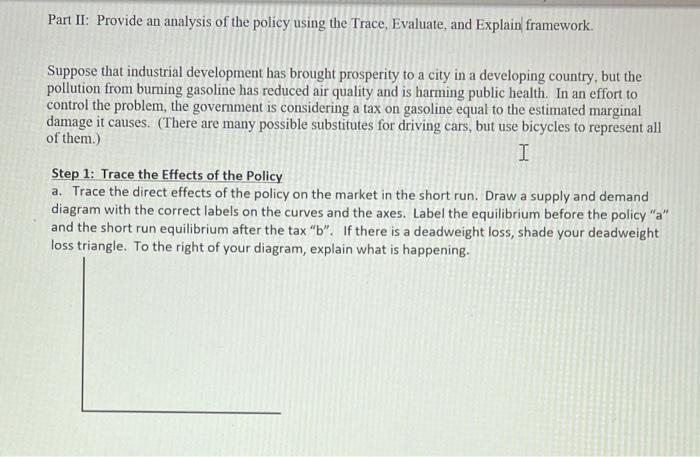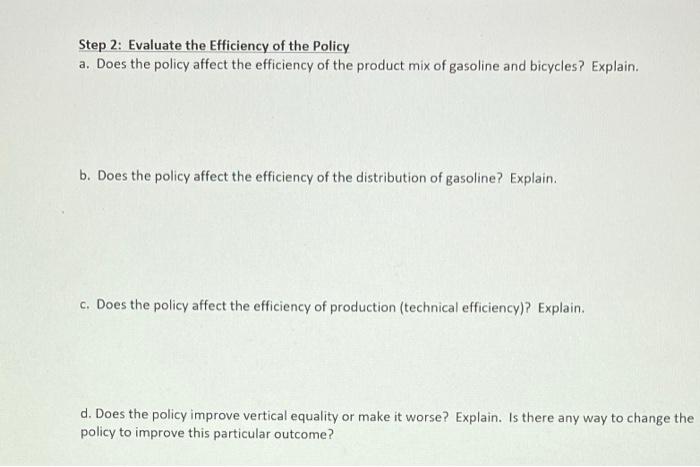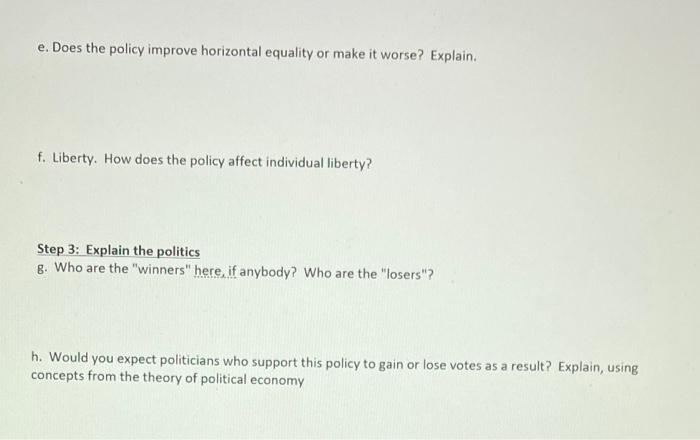Suppose that industrial development has brought prosperity to a city in a developing country, but the pollution from burning gasoline has reduced air quality and is harming public health. In an effort to control the problem, the government is considering a tax on gasoline equal to the estimated marginal damage it causes. (There are many possible substitutes for driving cars, but use bicycles to represent all of them.) Step 1: Trace the Effects of the Policy a. Trace the direct effects of the policy on the market in the short run. Draw a supply and demand diagram with the correct labels on the curves and the axes. Label the equilibrium before the policy "a" and the short run equilibrium after the tax "b". If there is a deadweight loss, shade your deadweight loss triangle. To the right of your diagram, explain what is happening. b. Draw and label the short run effects of the policy on the market for a substitute goodlabel your initial equilibrium point " a " and your new equilibrium point " b ". If there is a deadweight loss, shade your deadweight loss triangle. To the left of your diagram, explain what is happening. c. Are there any other effects you want to describe that may not appear on your diagrams? Step 2: Evaluate the Efficiency of the Policy a. Does the policy affect the efficiency of the product mix of gasoline and bicycles? Explain. b. Does the policy affect the efficiency of the distribution of gasoline? Explain. c. Does the policy affect the efficiency of production (technical efficiency)? Explain. d. Does the policy improve vertical equality or make it worse? Explain. Is there any way to change the policy to improve this particular outcome? e. Does the policy improve horizontal equality or make it worse? Explain. f. Liberty. How does the policy affect individual liberty? Step 3: Explain the politics g. Who are the "winners" here, if anybody? Who are the "losers"? h. Would you expect politicians who support this policy to gain or lose votes as a result? Explain, using concepts from the theory of political economy Suppose that industrial development has brought prosperity to a city in a developing country, but the pollution from burning gasoline has reduced air quality and is harming public health. In an effort to control the problem, the government is considering a tax on gasoline equal to the estimated marginal damage it causes. (There are many possible substitutes for driving cars, but use bicycles to represent all of them.) Step 1: Trace the Effects of the Policy a. Trace the direct effects of the policy on the market in the short run. Draw a supply and demand diagram with the correct labels on the curves and the axes. Label the equilibrium before the policy "a" and the short run equilibrium after the tax "b". If there is a deadweight loss, shade your deadweight loss triangle. To the right of your diagram, explain what is happening. b. Draw and label the short run effects of the policy on the market for a substitute goodlabel your initial equilibrium point " a " and your new equilibrium point " b ". If there is a deadweight loss, shade your deadweight loss triangle. To the left of your diagram, explain what is happening. c. Are there any other effects you want to describe that may not appear on your diagrams? Step 2: Evaluate the Efficiency of the Policy a. Does the policy affect the efficiency of the product mix of gasoline and bicycles? Explain. b. Does the policy affect the efficiency of the distribution of gasoline? Explain. c. Does the policy affect the efficiency of production (technical efficiency)? Explain. d. Does the policy improve vertical equality or make it worse? Explain. Is there any way to change the policy to improve this particular outcome? e. Does the policy improve horizontal equality or make it worse? Explain. f. Liberty. How does the policy affect individual liberty? Step 3: Explain the politics g. Who are the "winners" here, if anybody? Who are the "losers"? h. Would you expect politicians who support this policy to gain or lose votes as a result? Explain, using concepts from the theory of political economy










